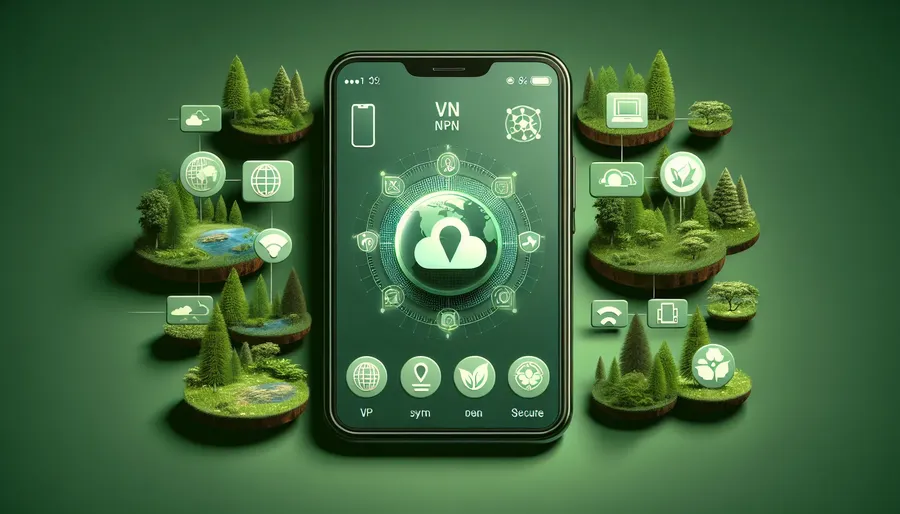Mastering VPN Setup on Your iPhone
Learn how to configure VPN on your iPhone easily. Enhance your online security with our step-by-step guide to VPN setup.

Setting up a VPN on your iPhone isn’t just a task for tech wizards; it’s a straightforward process that can enhance your online security and privacy. With the right guidance, anyone can configure a VPN on their iPhone, offering a secure browsing experience, whether you’re at a coffee shop or at home. Our focus today is on the steps needed to add VPN configuration to your iPhone, with a nod to ForestVPN—a reliable and eco-friendly option.
Why You Need a VPN on Your iPhone
In this age of connectivity, our iPhones are gateways to the world, but this connectivity can expose us to cyber threats. A VPN acts as a shield, encrypting your data and maintaining your anonymity. ForestVPN is a great choice for iPhone users, not only because it offers robust security features but also because it operates with an eco-conscious ethos—using less battery power and contributing to a reduced carbon footprint.
Steps to Configure VPN on Your iPhone
1. Download and Install ForestVPN
Head over to the App Store and download ForestVPN. It’s crucial to use a trusted app to ensure your data remains private and secure.
2. Open the Settings App
Navigate to your iPhone’s Settings. Scroll until you find General, and tap on it.
3. Access VPN Settings
Within the General settings, locate VPN & Device Management. Tap Add VPN Configuration to begin the setup.
4. Enter VPN Details
You’ll be prompted to enter the details of your VPN. Here’s what you need to fill in:
- Type: Choose the protocol (IKEv2, IPSec, or L2TP). ForestVPN supports IKEv2 for enhanced security.
- Server Address: Enter the server address provided by ForestVPN.
- Remote ID: Also provided by ForestVPN.
- Authentication: Use your ForestVPN credentials.
5. Save and Connect
Once you’ve filled in the necessary information, tap Done. To connect, toggle the switch next to the VPN configuration you just created.
Troubleshooting Common Issues
Sometimes, configuring a VPN can hit a snag. Here are a few common problems and their solutions:
- Connection Drops: If your VPN connection is unstable, try switching to another server location within the ForestVPN app.
- Cannot Add Configuration: Ensure your iPhone is updated to the latest iOS version. Outdated software can cause configuration issues.
- Permissions Denied: If you previously denied permissions, go back to
Settings>Privacyand ensure VPN permissions are enabled.
Benefits of Using ForestVPN
- Data Privacy: With no activity logs and a strong encryption protocol, your browsing stays private.
- Eco-Friendly: ForestVPN’s technology reduces battery consumption, which is great for the environment and your device.
- UAE Licensed: It’s legal and safe to use in the UAE, providing you with peace of mind.
Tips for an Optimal VPN Experience
- Switch Locations: If your connection slows down, try a different server location for faster speeds.
- Monitor Your Usage: Use the statistics feature in ForestVPN to keep track of your data usage.
- Utilize Split Tunneling: Available on Android, this feature allows you to choose which apps use the VPN, conserving data and bandwidth.
Final Thoughts
Adding a VPN to your iPhone is a smart move in today’s digital landscape. It provides security, privacy, and freedom online. ForestVPN is an excellent choice, offering a user-friendly experience with a commitment to sustainability. By following the steps outlined above, you can easily set up a VPN on your iPhone and enjoy a safer, more private browsing experience.
Remember, a VPN is more than just a tool—it’s your passport to a secure digital world. Whether you’re accessing geo-restricted content or ensuring your online activity remains confidential, a reliable VPN like ForestVPN is invaluable.
In conclusion, configuring a VPN on your iPhone is an accessible task that everyone can accomplish with the right guidance. ForestVPN not only provides top-notch security features but also aligns with eco-conscious values, making it a standout choice. By following our step-by-step guide, you’ll be well on your way to a safer and more private online experience. Happy browsing!
How to Add VPN Configuration on iPhone
Adding a VPN configuration on your iPhone is simple! Follow these steps:
Step-by-Step Guide
- Download ForestVPN from the App Store.
- Open Settings and go to General.
- Tap on VPN & Device Management > Add VPN Configuration.
- Fill in the Details:
– Type: IKEv2
– Server Address: Provided by ForestVPN
– Remote ID: Provided by ForestVPN
– Authentication: Your ForestVPN credentials - Save and Connect!
Enjoy secure browsing with ForestVPN—the eco-friendly choice for your online privacy! Get started now: ForestVPN.
FAQs About Setting Up a VPN on Your iPhone
Why should I use a VPN on my iPhone?
Using a VPN on your iPhone enhances your online privacy by encrypting your data and hiding your browsing activity from your internet service provider and other entities. It is particularly useful when connecting to public Wi-Fi networks, where your information may be vulnerable to snooping.
How do I download and install ForestVPN on my iPhone?
To download ForestVPN, open the App Store on your iPhone, search for ForestVPN, and tap the ‘Get’ button. Once the installation is complete, you can find it on your home screen to start the configuration process.
What should I do if I cannot save my VPN configuration?
If you’re unable to save your VPN configuration, ensure that your iPhone is updated to the latest iOS version. Restarting your device can also help resolve any temporary glitches.
Can I use ForestVPN for free?
ForestVPN offers various subscription levels, but it is essential to note that completely free VPN options are often not secure. Investing in a reputable VPN like ForestVPN ensures better privacy and security.
What are the benefits of using ForestVPN specifically?
ForestVPN provides high-level encryption to protect user data, has no activity logs, and operates with an eco-friendly approach, using less battery power while maintaining performance.
